EXCRETION Questions
1/33
There's no tags or description
Looks like no tags are added yet.
Name | Mastery | Learn | Test | Matching | Spaced |
|---|
No study sessions yet.
34 Terms
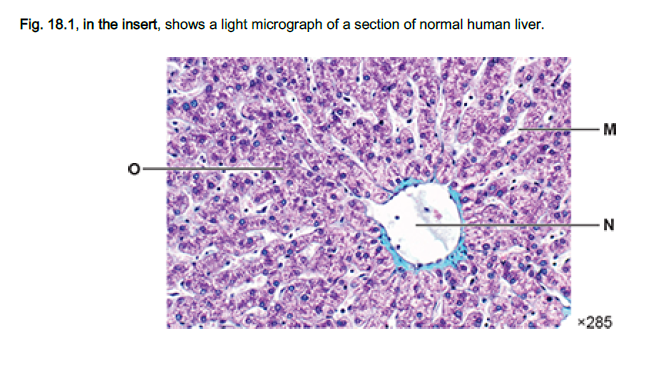
Identify the structures labelled N and O
N = central vein / intralobular blood vessel ✓
O = hepatocyte / liver cell ✓
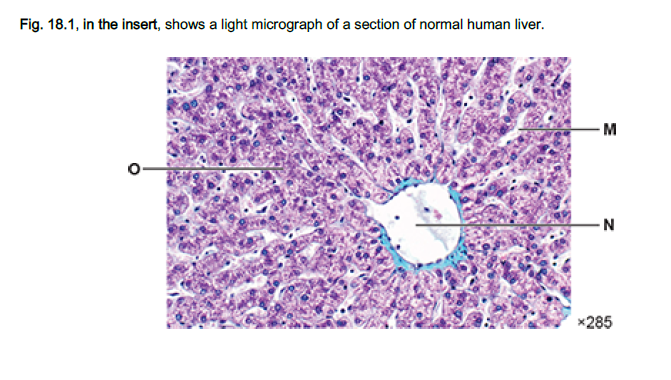
The walls of the structure labelled M in Fig. 18.1 are lined with cells.
Suggest and explain how these cells are adapted to carry out their function (2)
thin / flat, cells ✓
short diffusion distance ✓
OR
fenestrated / AW ✓
increases permeability ✓
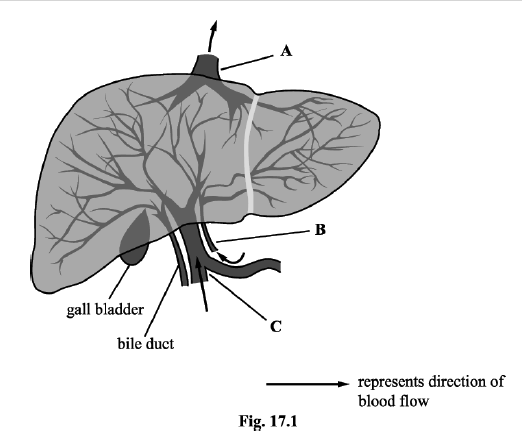
Identify, with reasons, each of the blood vessels labelled A – C
A hepatic vein as blood leaving liver (1)
B hepatic artery as blood entering liver through narrow vessel (1)
C hepatic portal vein as blood (from gut) entering liver through branched vessel (1)
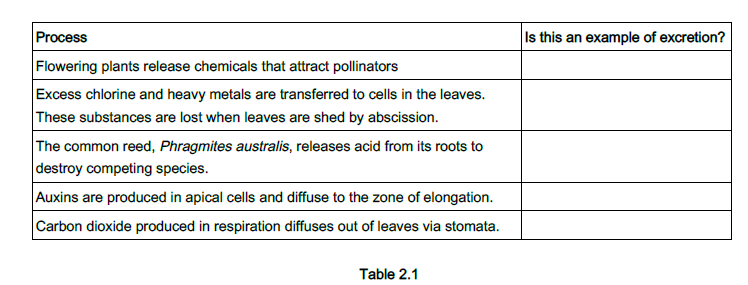
Excretion is important in both animals and plants.
Table 2.1 describes some processes that occur in plants.
In Table 2.1, write YES or NO in each box in the right-hand column to indicate whether or not each statement is
an example of excretion.
NO
YES
NO
NO
YES
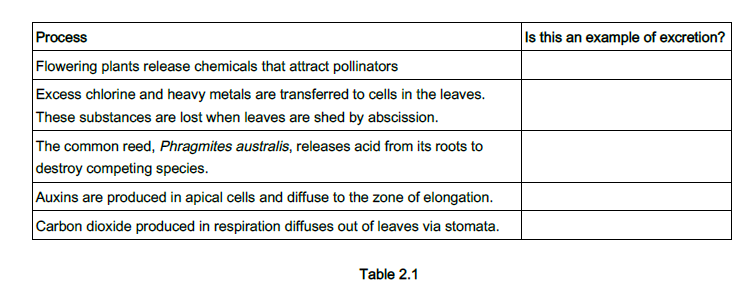
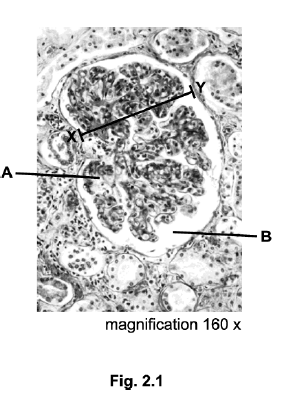
The kidney is one of the organs of excretion in vertebrate animals.
Fig. 2.1 shows a light micrograph of a section through a kidney cortex.
(i) Name the parts of the kidney labelled A and B.
A = Glomerulus (1)
B = Bowman's capsule (1)
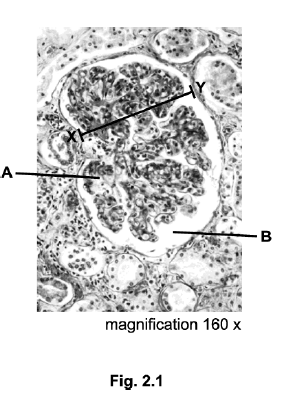
Sodium ions and glucose are both reabsorbed into the blood from proximal convoluted tubules (PCTs) in the
kidney.
(i) A student designed an experiment to investigate the effect of temperature on the rate of glucose diffusion
through dialysis tubing.
State two factors that would need to be controlled in this experiment
initial / AW, glucose concentration (on both sides on the membrane) (1)
volume of solution (1)
length / diameter, of dialysis tubing (1)
type / brand, of dialysis tubing (1)

Sulthiame is a drug that inhibits the enzyme carbonic anhydrase.
Fig. 2.2 shows the role of carbonic anhydrase in the PCT of the kidney.
Using the information in Fig. 2.2, what can you conclude about the likely effect of sulthiame on the
reabsorption of sodium ions in the PCT? (3)
(less reabsorption because)
idea of fewer H+ ions in PCT cells (1)
less / no, co-transport / facilitated diffusion,
of Na+ ions, into cells / from lumen (1)
less / no, active transport of Na+ ions into,
blood (1)

Most excess amino acids are metabolised in the liver, resulting in products that are relatively harmless to the
body.
The figure outlines the first step in the metabolism of amino acids in the liver.
State the name given to this reaction.
Identify the toxic product of the reaction.
deamination;
ammonia / NH3;
Complete the following passage by inserting the most suitable word or term.
The figure shows the first step in the metabolism of amino acids in the liver. The next step involves a series of
reactions known as the _ _ _ _ _ _ _ _ _ _ _ _ _ _ _ _ _ _ _ _ _ cycle. The toxic product X enters the cycle together with _ _ _ _ _ _ _ _ _ _ _ _ _ _ _ _ _ _ _ _ _ , resulting in the formation of the final nitrogenous product _ _ _ _ _ _ _ _ _ .
The nitrogenous product is transported to the _ _ _ _ _ _ and then via the ureter to the _ _ _ _ _ _ _
_ _ __ _ where it is stored as _ _ _ _ _ _ _ _ _ _ _ _ _ _ _ _ _ _ _ _ _ before leaving the body.
ornithine;
carbon dioxide / CO2;
urea / CO(NH2)2;
kidney / nephron / renal tubule /glomerulus;
bladder;
urine
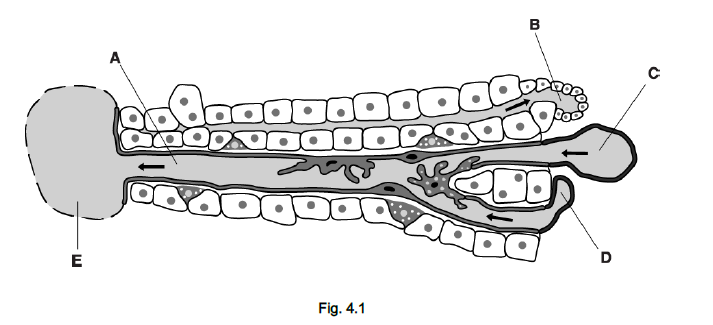
Identify the parts labelled A to E.
A sinusoid;
B (branch of) bile duct;
C (branch of) hepatic portal vein;
D (branch of) hepatic artery / arteriole;
E (branch of) hepatic / central, vein;
The liver has considerable powers of regeneration, even if a high proportion of its cells are damaged.
Name the liver cells that can lead to this regeneration AND the type of cell division that they carry out.
Hepatocytes;
mitosis.
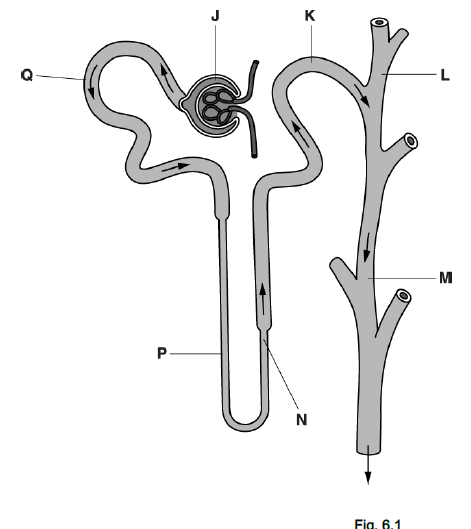
Use the letter or letters from Fig. 6.1 to identify:
(i) the region or regions where glucose is selectively reabsorbed into the blood capillaries
(ii) the region or regions present in the cortex
(iii) the region or regions where podocytes are located
(i) Q;
(ii)Q and J and K and L;
(iii) J
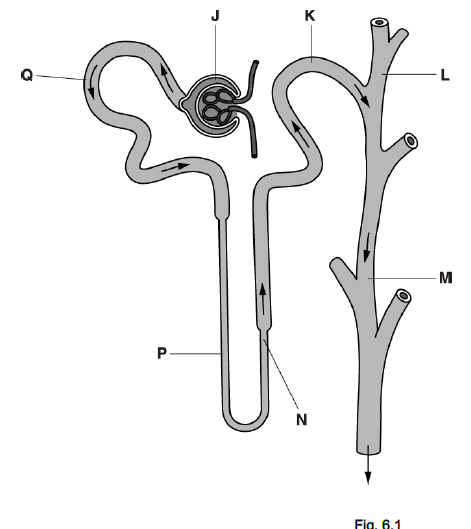

Which letter or letters label areas of the nephron which are directly affected by ADH?
M
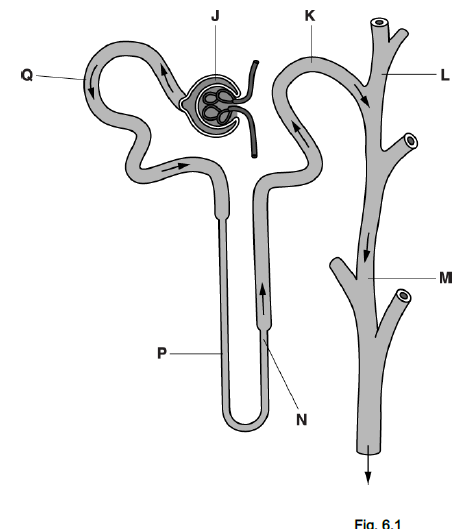
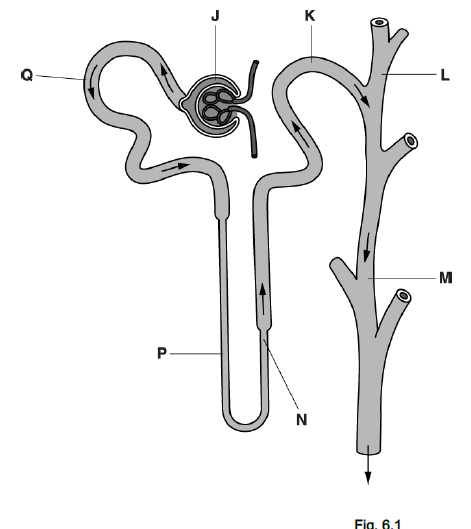
The desert kangaroo rat, Dipodomys deserti, lives in dry and hot conditions. It excretes a very small volume of urine relative to its size.
The loops of Henle in the kidneys of these mammals are longer than those found in mammals of a similar size that do not live in desert conditions.
Explain how the longer loop of Henle is able to assist the desert kangaroo rat in preventing excessive water loss.
1 more (sodium and chloride) ions
pumped, out of ascending limb / into
medulla;
2 builds up greater water potential
gradient;
3 allows, reabsorption / removal, of more
water from, collecting duct / M;
Suggest why patients receiving peritoneal dialysis usually need to have the peritoneal dialysis fluid replaced
four times a day, but those receiving haemodialysis only need treatment three times a week. (2)
1 peritoneal dialysis can remove less (named) waste (than haemodialysis);
2 idea that in haemodialysis dialysis fluid is constantly, refreshed / changed (but not in peritoneal dialysis);
3 haemodialysis uses counter-current flow;
4 idea that haemodialysis maintains concentration gradient
or
in peritoneal dialysis the concentration gradient, reduces / is lower;
5 (in peritoneal dialysis) the fluid reaches equilibrium with the blood;
Why does the dialysis fluid used in peritoneal dialysis contain dextrose solution rather than water alone? (2)
1idea that (dialysis is replicating function
of kidney and) part of kidney's function
is to remove (excess) water from
blood;
2(dextrose / sugar) reduces, water
potential / (of dialysis fluid)
or
(dextrose / sugar, solution) has a
lower, water potential / (than water);
3water moves from blood (into dialysis
fluid) by osmosis
or
prevents water moving into the blood
(from dialysis fluid) by osmosis;
4(if it was water alone) cells would, swell
/ burst;
The peritoneum is a membrane that lines the abdominal cavity and is well supplied with blood capillaries.
The peritoneum acts as a surface across which waste can be removed.
How might the peritoneum differ in its function from the artificial membrane in a dialysis machine used in
haemodialysis? (1)
it can perform, active transport / facilitated
diffusion;

Explain, with reference to Fig. 19.2, why some foods affect urine production( 4)
salted crisps AND boiled sweets reduce water potential of blood (because of high sugar / salt content) ✓
osmoreceptors in hypothalamus, detect change in water potential in blood / cause increased release of ADH ✓
ADH causes production of aquaporins in collecting duct so more water is reabsorbed (into capillaries) ✓
bread / milk / chocolate, increase water potential of blood ✓
causes reduced ADH release ✓
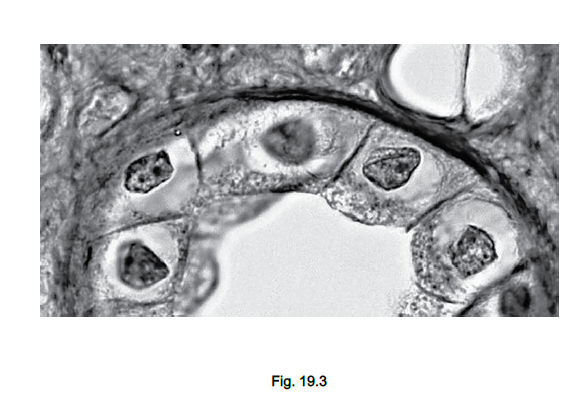
Fig. 19.3 is a light microscope image of kidney tubule cells.
State three structures within the tubule cells that are not visible in this image.
ribosomes ✓
mitochondria ✓
(rough / smooth) endoplasmic reticulum ✓
Golgi apparatus ✓
vesicle ✓
centriole ✓
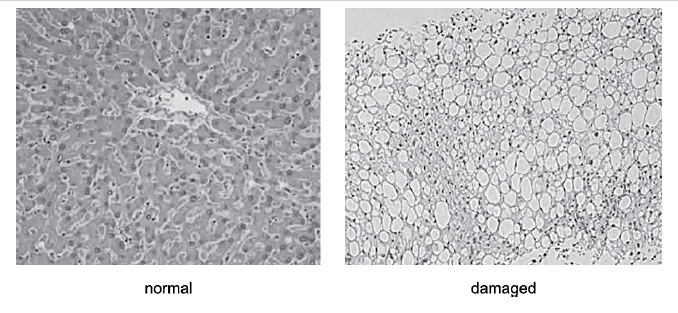
Describe two ways in which the liver tissue damaged by cycasin is different from normal liver tissue
(large) gaps / holes, in tissue / between cells ✓
cell death ✓
idea that usual structure of liver tissue is not present ✓ e.g. sinusoids not present
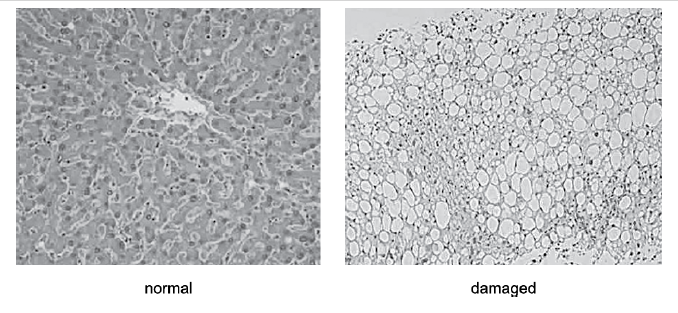
The hormone hCG can be detected in urine using pregnancy tests.
Which of the following properties of the hormone hCG allows it to be detected in urine?
B hCG has a molecular mass of less than 69,000
Patients with kidney failure can be treated in different ways.
Which of the following statements describes a feature of peritoneal dialysis?
1 Urea and mineral ions pass into the tissue fluid.
2 Blood is passed over an artificial membrane to remove toxins.
3 The patient receives immunosuppressant medication
Only 1
Explain why peritoneal dialysis can use active transport and diffusion while haemodialysis relies on diffusion alone.(2)
peritoneal wall is made up of living cells ✓
(so) produces ATP to carry out active transport ✓
dialysis membranes, only allow diffusion / cannot do active transport ✓
Suggest one advantage and one disadvantage of a kidney transplant compared to dialysis.
advantage:
does not require repeated dialysis OR diet
less limited OR better quality of life / no
longer chronically ill ✓
disadvantage:
idea of difficulty finding donor organ OR
risks of surgery OR risks from, organ
rejection / long term immunosuppressant
drugs ✓
Cancer of the bladder or kidneys can now be detected using a simple procedure.
Suggest a non-invasive method that could be used to test for these cancers.
test urine ✓
excrete nitrogenous waste as guanine instead of urea. Guanine is synthesised from ammonia in the liver.
The following statements relate to guanine:
1 ammonia is more toxic than guanine
2 urea is more soluble in water than guanine
3 guanine has a high proportion of nitrogen
Which of the statements correctly explains why birds excrete guanine?
1,2, and 3
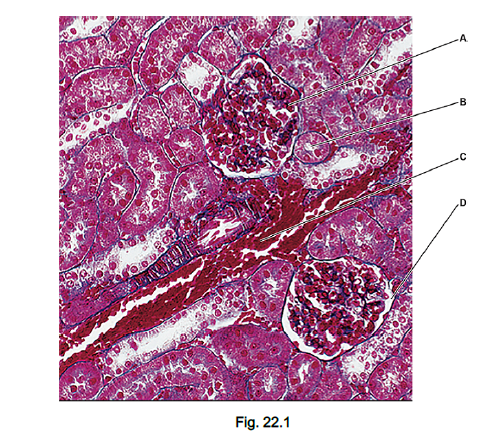
(i) Which letter identifies the region with the highest hydrostatic pressure?
(ii) Which two letters identify regions that do not contain plasma proteins?
A
B,D
Studies of the cell surface membranes of the distal convoluted tubule have provided the following evidence:
Sodium-potassium pumps:
– move potassium ions from the blood to the tubule fluid
– move sodium ions from the tubule fluid to the blood
– use ATP in these processes.
Sodium-calcium co-transport proteins:
– move calcium ions from the tubule fluid to the blood
– move sodium ions into the tubule fluid
– use the electrochemical gradient of sodium ions to drive this process.
(i) Using this information and your own knowledge, compare the processes occurring in the proximal and distal
convoluted tubules. ()
similarities
S1 both use active transport ✔
S2 both involve, co-transport / described ✔
S3 both involve selective reabsorption ✔
S4 both involve use of, sodium ions / Na+✔
differences
D1 DCT involves use of, calcium ions /Ca2+ ✔
D2 (co-transport in) DCT involves ions only✔
D3 PCT involves ions and (named) molecules ✔
Nephrogenic diabetes insipidus is a disease of the kidney that affects the regulation of water potential in the
blood. One cause is lithium poisoning. Lithium ions enter the kidney tubules through sodium channels.
This prevents the cells of the collecting duct from responding to ADH in the blood.
State and explain one symptom you would expect to observe as a result of nephrogenic diabetes insipidus
symptom
high volume of / excess, urine
OR
always thirsty / AW ✔
explanation
fewer / AW, aquaporins in the (plasma) membrane (of collecting duct cells) ✔
Explain why podocytes are usually unable to undergo mitosis.(3)
1 have already / are, differentiated / specialized (so cannot divide) ✔
3 idea that shape is (too), irregular / asymmetrical (so cannot divide) ✔
4 cytoskeleton cannot function / spindle (fibres) cannot form✔
5 (if mitosis occurred) it would alter, number / size, of the, gaps /fenestrations ✔
6 idea that it would alter an aspect of ultrafiltration ✔
A person’s glomerular filtration rate (GFR) provides an indication of the health of their kidneys. The GFR is a measure of the volume of blood that can be filtered by the kidneys every minute.
GFR can be estimated by monitoring the blood concentration of creatinine, which is a breakdown product of creatine phosphate in muscles.
(i) Suggest two characteristics of a patient that must be taken into account when using this GFR measurement to diagnose kidney damage.
Explain why each characteristic must be considered. ()
age ✓
(because) GFR / kidney function , declines with age ✓
gender ✓
(because) men and women have different muscle mass ✓
exercise / muscle activity / muscle mass / fitness / pregnancy / body mass✓
(because this will) alter, metabolism of creatine (phosphate) / production of creatinine ✓
diet ✓
(because this will) affect levels of, creatine (phosphate) / creatinine ( in the blood) ✓
ethnicity / genetic make up ✓
different alleles, affect metabolism of creatine (phosphate) / production of
creatinine ✓
When old red blood cells are broken down, each haem group is converted to a molecule called bilirubin. Bilirubin
passes through the digestive system. Bilirubin gives faeces their characteristic colour.
Explain why bilirubin production and processing is an example of excretion. (2)
(bilirubin is a) metabolic waste product / described ✓
as produced, from haem / during (red blood cell) breakdown ✓
(bilirubin) removed / AW, from the body ✓

State one function of the distal convoluted tubule
Describe the function of the structures labelled A in Fig. 1.2.
Suggest which lumen, B or C, has the highest concentration of urea. Explain your answer.
(re)absorption / regulation, of (named) ions e.g. Cl- / K+ / Na+ / Ca2+,
increase(s) surface area for,(re)absorption/active transport ✓
has, cotransporters / membrane proteins, for (re)absorption / active transport, of Na+/ amino acid /glucose ✓
B AND (because) water, is reabsorbed / removed, earlier in the nephron/AW
* Water reabsorption in the kidney is controlled by the endocrine and nervous systems.
Aldosterone and ADH are hormones that act on the kidney.
Aldosterone causes sodium ions to be pumped from the collecting duct cells into tissue fluid.
Describe how the endocrine and nervous systems work together to increase water reabsorption from the
collecting duct.
Endocrine system
hypothalamus causes release of ADH from pituitary
aldosterone released from adrenal cortex
ADH released from pituitary gland
ADH binds to receptors on the cell
membranes of collecting duct cells …
… and this increases permeability to
water (regulated by aquaporins)
role of cAMP
Nervous system:
osmoreceptors in the hypothalamus detect a low water potential in the blood
ADH is produced in the hypothalamus
correct reference to negative feedback
Aldosterone:
sodium ions pumped out of collecting duct cells (into tissue fluid) (and potassium ions pumped in)
lowers water potential in tissue fluid
concentration gradient established
sodium ions reabsorbed from the collecting duct lumen
water diffuses into collecting duct cells via osmosis.